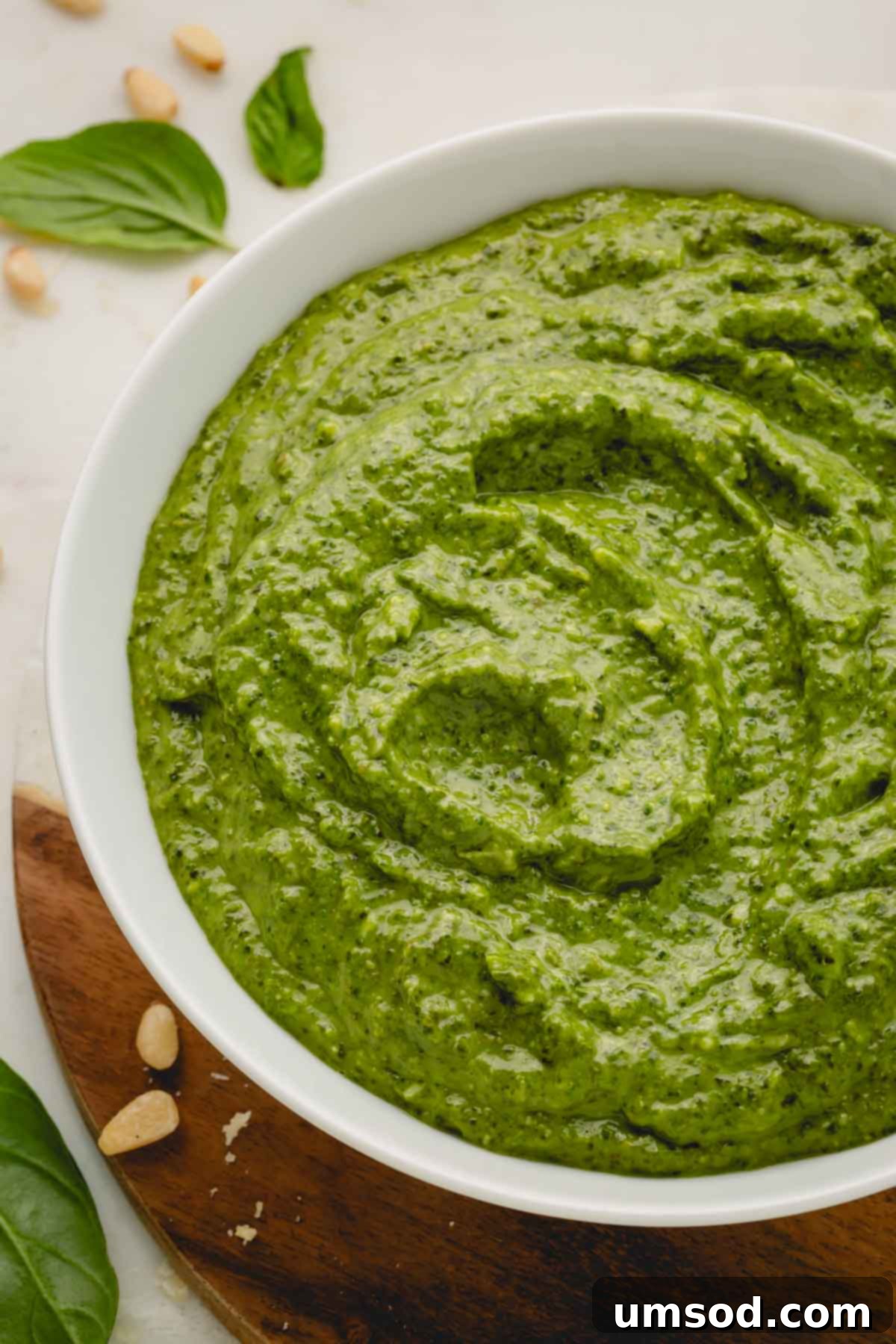There’s nothing quite like the vibrant, aromatic taste of freshly made basil pesto. Its bright, savory notes transform any dish, from simple pasta to elegant salmon. If you’re tired of tiny, expensive store-bought jars that disappear too quickly, then you’re in the right place! This ultimate big batch basil pesto recipe is designed for maximum flavor and convenience. Made with just six simple, high-quality ingredients, it yields over 5 cups of rich, smooth, and utterly delicious pesto that easily surpasses anything you’ll find on grocery store shelves. Best of all, it’s perfect for freezing, ensuring you have the taste of summer basil all year long.

“When in doubt, add some pesto” is a motto many home cooks live by, and for good reason! Pesto is incredibly versatile and can elevate countless meals. Lucky for us, basil thrives in summer gardens, often producing an abundance of fragrant leaves. This recipe is the perfect way to harness that seasonal bounty, turning fresh basil into a culinary goldmine you can enjoy whenever the craving strikes.
Why You’ll Fall in Love with This Big Batch Pesto Recipe
This isn’t just another pesto recipe; it’s a game-changer for anyone who loves fresh flavors and efficient cooking. Here’s why this recipe will become a staple in your kitchen:
- Effortlessly Simple Ingredients – Believe it or not, crafting this gourmet pesto requires only six fundamental ingredients. The magic truly happens when high-quality, fresh produce is combined, delivering a depth of flavor that’s both complex and comforting.
- Incredibly Quick and Easy – Forget complicated cooking techniques. With no stovetop cooking involved and minimal prep, you can whip up this homemade basil pesto in just about 15 minutes. It’s the ultimate grab-and-blend solution for busy weeknights or impromptu gatherings.
- Generous Large Batch Yield – If you’re like me, those tiny store-bought pesto jars never last long enough. This recipe addresses that common frustration head-on, producing a substantial 5½ cups of pesto. This means you’ll have plenty to enjoy immediately and ample to freeze, ensuring you can generously pour, layer, and spread pesto on everything imaginable without holding back!
- Superior Taste and Texture – Once you experience the vibrant flavor and luxuriously creamy texture of homemade pesto, you’ll find it impossible to go back to processed, store-bought alternatives. The freshness is simply incomparable.
Mastering the art of homemade basil pesto opens up a world of culinary possibilities. Keep a steady supply on hand to effortlessly enhance dishes like pesto salmon, indulge in pesto mozzarella chicken meatballs, serve up a delectable pesto artichoke dip, or toss it with your favorite basil pesto pasta for a quick and satisfying meal.
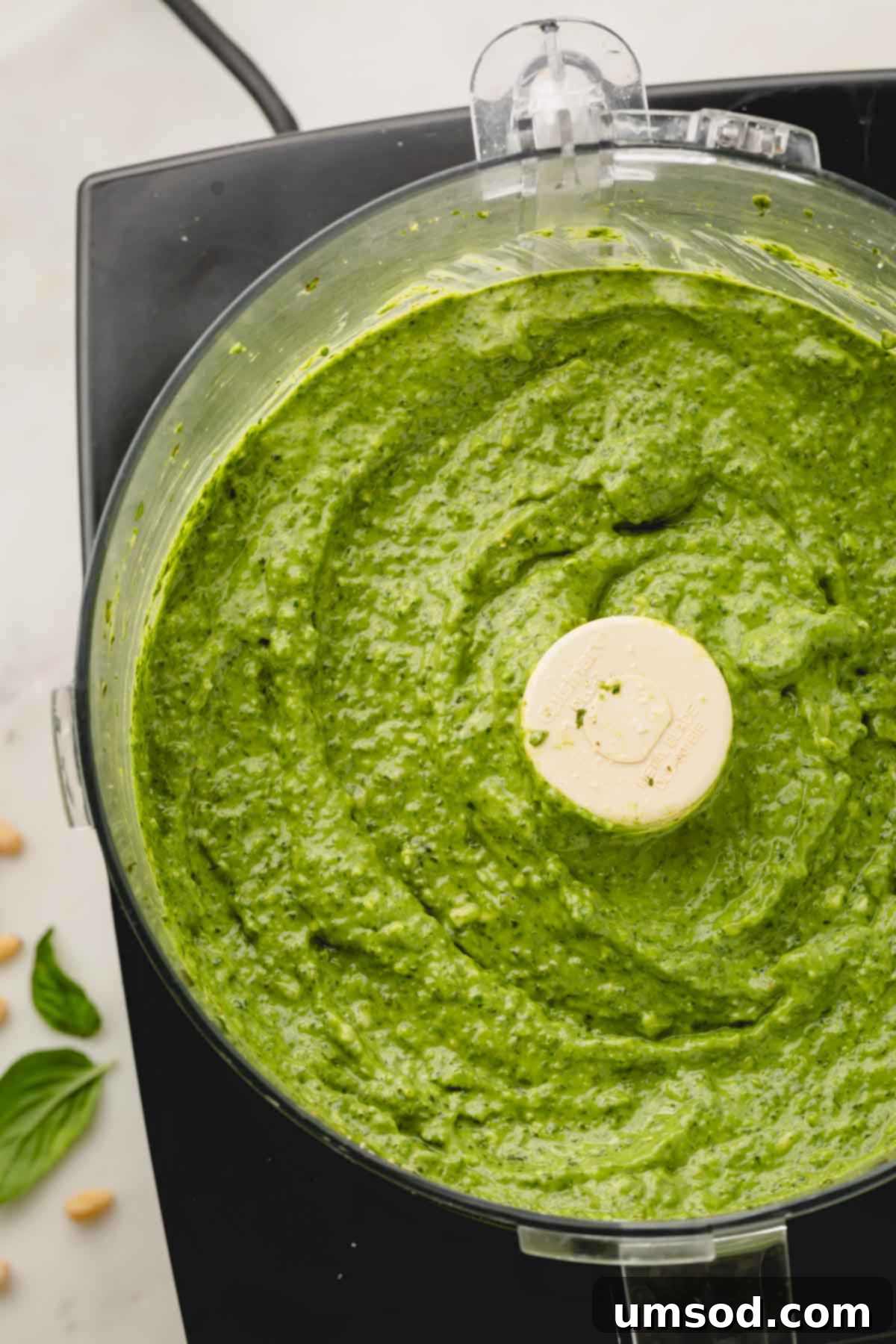
Pin this recipe now to easily find it later!
Pin It
Essential Ingredients for Perfect Basil Pesto
The secret to an exceptional pesto lies in the quality and freshness of its components. Here’s a closer look at the key ingredients and how to choose them for the best results:
- Fresh Basil Leaves – The foundation of any great basil pesto! Always opt for the freshest basil you can find. Look for bright green leaves without any wilting, brown spots, or signs of damage. If you’re lucky enough to grow your own, harvest it just before making the pesto for peak flavor. The more vibrant the basil, the more flavorful and visually appealing your pesto will be.
- Pine Nuts – These small, creamy nuts are a traditional element in pesto, lending a distinct, buttery texture and a subtly sweet, nutty flavor. To truly unlock their aromatic potential, a quick toast is essential. If pine nuts aren’t available or you have allergy concerns, excellent alternatives include walnuts (which offer a more robust, slightly earthy flavor), almonds (milder and creamier), cashews, or even sunflower or pumpkin seeds for a nut-free option.
- Garlic – For the most pungent and authentic flavor, fresh garlic cloves are a must. Skip the pre-minced jarred variety. This recipe calls for a generous amount, at least 15 cloves, to ensure a robust garlicky punch. If you’re a true garlic enthusiast, feel free to add more! For those who prefer a milder garlic flavor, you can briefly toast the peeled cloves in a dry skillet for a few minutes, or even blanch them quickly, to mellow their intensity.
- High-Quality Olive Oil – More than just a binder, extra virgin olive oil is a crucial flavor component. It helps to loosen the ingredients, transforming the pesto from a thick paste into a luxuriously smooth, emulsified sauce. Choose a good quality extra virgin olive oil for its rich, fruity, and slightly peppery notes, which also contribute a boost of healthy fats.
- Parmigiano-Reggiano Cheese – This specific type of Parmesan cheese, protected by its region of origin in Italy, offers a deeply rich, complex, and slightly nutty flavor profile that elevates your basil pesto to gourmet status. You’ll typically find it in the specialty cheese section of your grocery store. While regular Parmesan cheese can be used, the superior taste of Parmigiano-Reggiano is undeniable. For the absolute best flavor and texture, always buy a block and grate it fresh yourself; pre-grated cheeses often contain anti-caking agents that can affect the texture.
- Fresh Lemon Juice – A squeeze of fresh lemon juice is indispensable. The citrus acidity provides a brilliant counterpoint to the richness of the olive oil and cheese, balancing the flavors and adding a bright, zesty finish. It also helps to prevent the pesto from oxidizing and turning brown, keeping its vibrant green hue intact. Always use freshly squeezed for the best results.
Combining these top-tier ingredients ensures a pesto that is not only delicious but also vibrantly fresh and bursting with authentic flavor.

Crafting the Perfect Big Batch Basil Pesto: A Step-by-Step Guide
Making a large batch of homemade basil pesto is surprisingly simple, especially with a few clever techniques. Follow these steps for a consistently delicious and creamy result:
Preparing Your Basil for Optimal Texture
- Begin by meticulously washing your fresh basil leaves to remove any dirt or impurities. It’s crucial to then thoroughly dry them. Excess moisture can lead to a watery pesto and affect its shelf life.
- Once dry, arrange the basil leaves in a single layer on a baking sheet. Place the baking sheet in the freezer for 1-2 hours, or until the leaves are completely solid. This freezing step is key to achieving that velvety smooth texture we all crave in pesto.
The Secret to a Creamy, Vibrant Pesto Sauce: Freezing Basil
This ingenious technique, inspired by culinary experts like Serious Eats, is a game-changer for pesto texture. When basil leaves freeze, ice crystals form within their plant cells. These crystals effectively rupture the cell walls, mimicking the crushing action of a traditional mortar and pestle. This pre-breaks down the basil, allowing it to blend much more easily and uniformly with the oil and cheese. The result? A perfectly emulsified sauce that is less grainy, beautifully velvety, and retains a much brighter green color.
Attempting to blend fresh basil directly in a food processor often results in a chunkier, sometimes duller-colored sauce that can also be less flavorful due to incomplete cell breakdown.

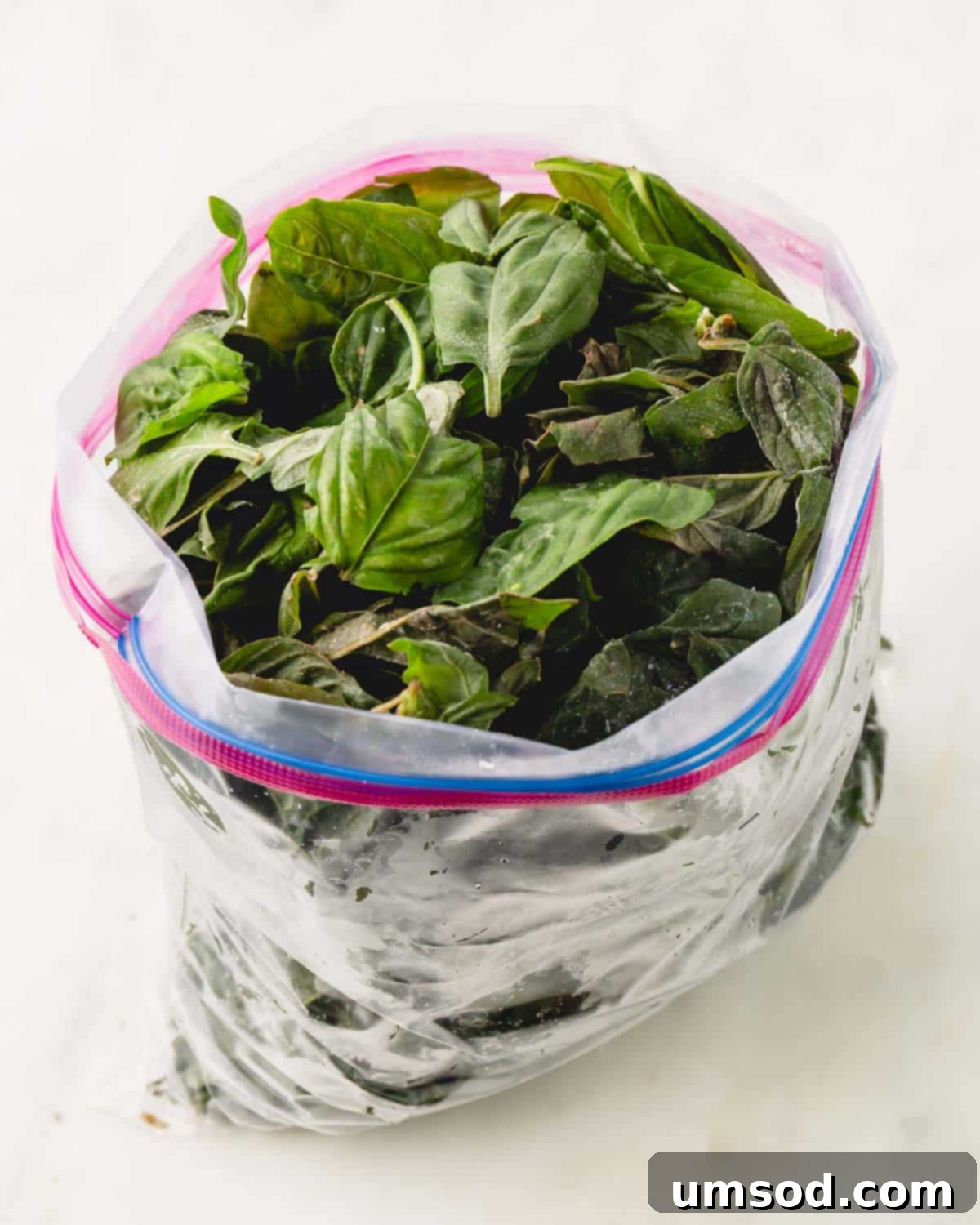
Toasting Nuts and Prepping Garlic
- Toast the pine nuts in a dry medium skillet over medium heat. Stir them frequently to ensure even browning. Pine nuts can go from perfectly golden to burned very quickly, so keep a watchful eye on them. As soon as they become fragrant and lightly golden brown, immediately remove them from the heat and transfer them to a plate to cool. This crucial step deepens their nutty flavor and adds another layer of complexity to your pesto.
- Peel the garlic cloves. A simple trick is to place the flat side of a chef’s knife over each clove and give it a firm smash. The skin will loosen, making it easy to peel.
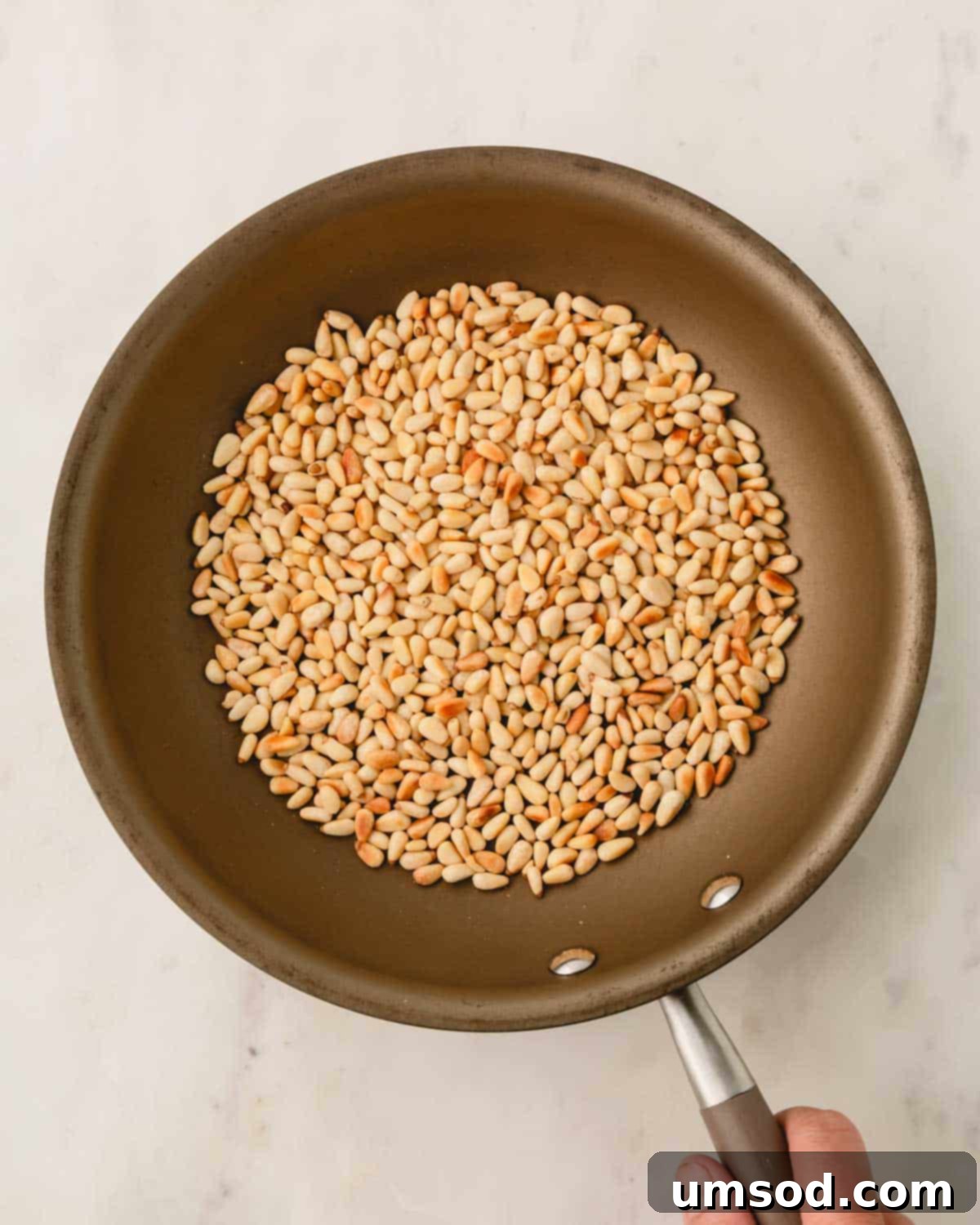

Blending the Core Ingredients
- In a large food processor (a 14-cup model is ideal for this big batch), place the frozen basil leaves, toasted pine nuts, peeled garlic, and kosher salt. For easier blending and to ensure everything is evenly processed, I recommend placing the heavier garlic and pine nuts at the bottom of the food processor bowl.
- Process these ingredients until they form a thick, vibrant green paste. This initial blending breaks down the solids before the oil is introduced.
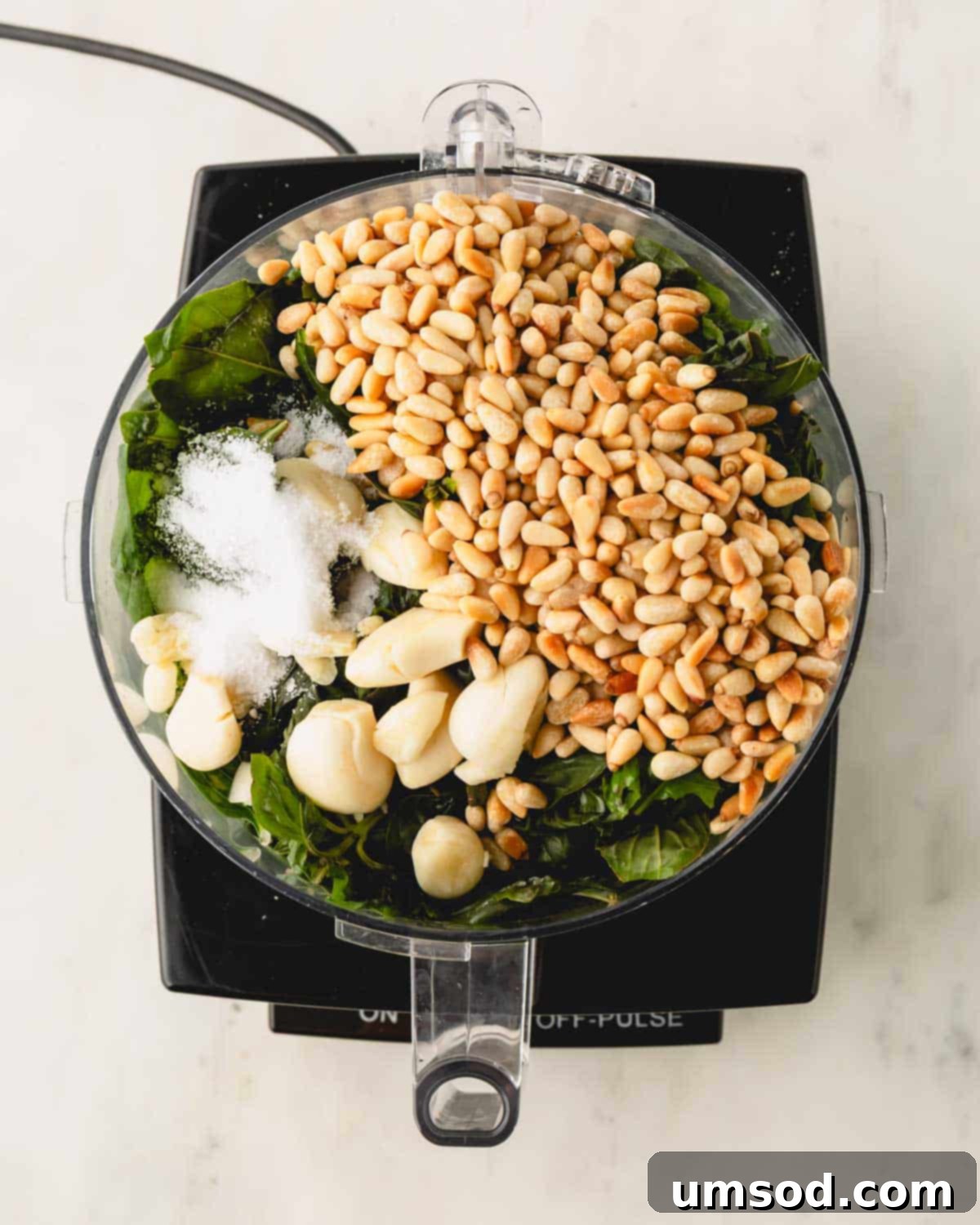

Emulsifying and Finishing Your Pesto
- With the food processor still running, slowly drizzle in the olive oil through the feed tube. This gradual addition is critical for proper emulsification, resulting in a smooth, creamy sauce rather than a separated mixture. Watch as the pesto transforms into a luscious, cohesive sauce.
- Once the oil is incorporated, add the freshly grated Parmigiano-Reggiano cheese and the fresh lemon juice.
- Process for another 30 seconds or just until all the ingredients are fully combined and the pesto reaches your desired consistency. Be careful not to over-process, as this can generate too much heat, dulling the basil’s vibrant color and potentially making the pesto bitter.
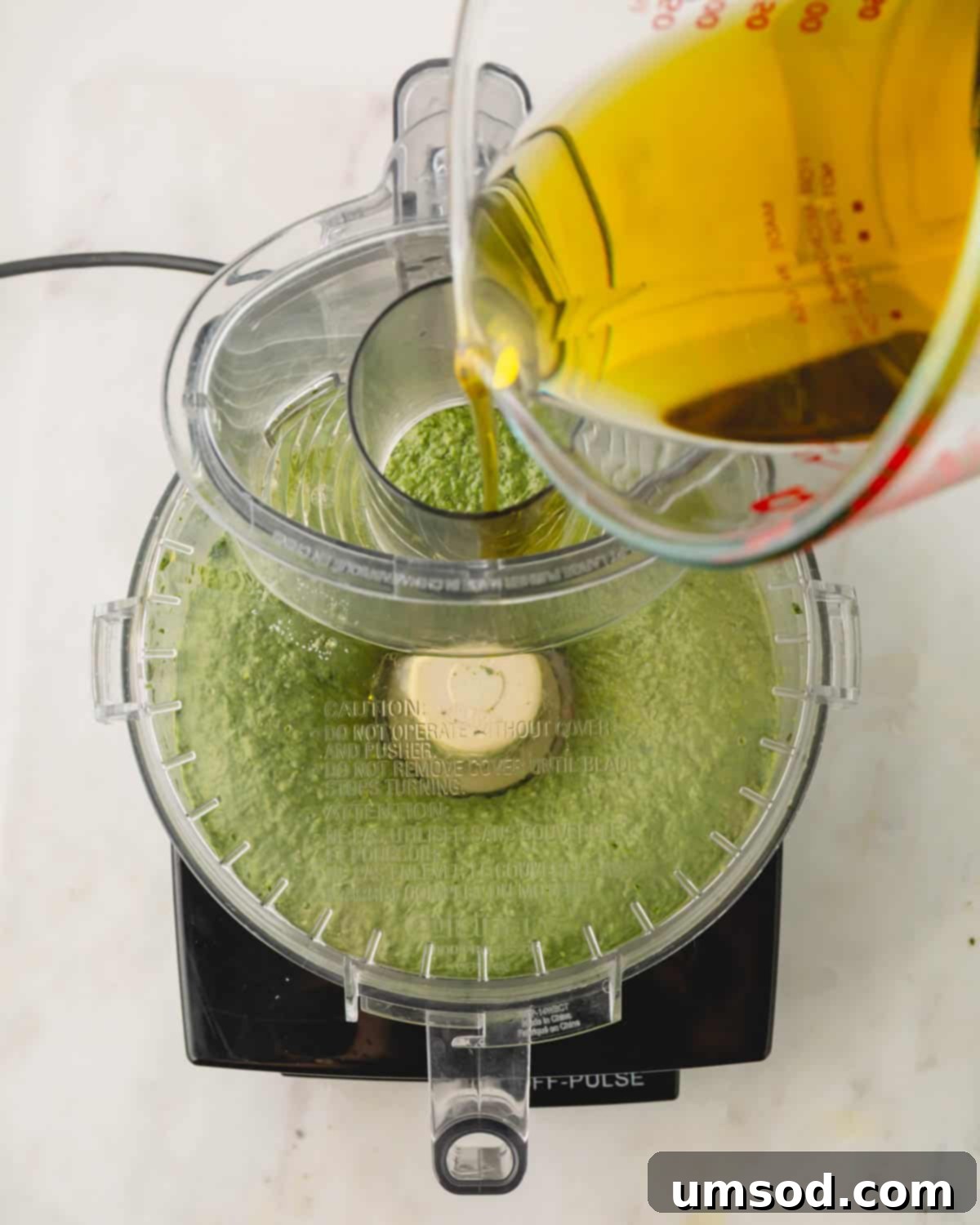

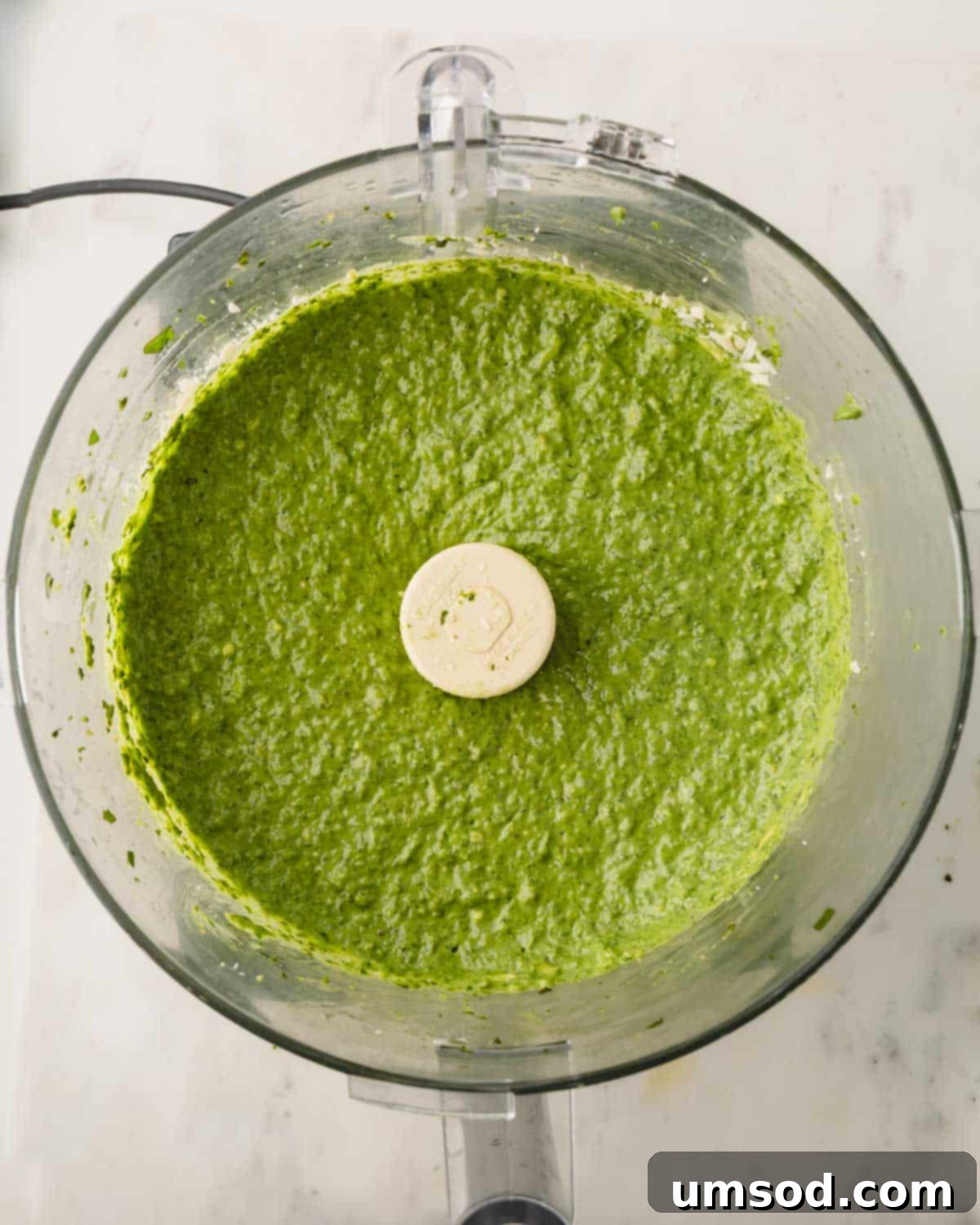
Smart Prep Ahead Tip
To make pesto making even quicker, prepare your basil leaves well in advance. Wash, dry, and freeze them as directed for up to 3 months. Store them in a freezer-safe bag or container until you’re ready to transform them into glorious pesto.
Unlock Endless Flavor: Creative Ways to Use Basil Pesto
This big batch basil pesto isn’t just a sauce; it’s a versatile flavor enhancer ready to elevate almost any meal. Its bright, herbaceous profile is truly universal, pairing beautifully with everything from simple snacks to elaborate dinners. In my opinion, there’s hardly anything this recipe doesn’t improve!
While it’s the perfect addition to classic pasta dishes, rich sauces, hearty sandwiches, and creamy dips, don’t limit your imagination. Here are some of my favorite ways to incorporate this homemade goodness:
- Pasta Perfection: Toss with hot pasta for a quick and satisfying meal. Stir into pesto ricotta stuffed pasta shells for a gourmet touch.
- Protein Power-Up: Spread over fish before baking, like my pesto baked salmon, or use as a marinade for chicken or shrimp. Drizzle over grilled chicken breasts or incorporate into stuffed chicken roll-ups.
- Pizza and Flatbread Base: Swap out traditional tomato sauce for a layer of pesto on your pizza, like this cheesy roasted tomato pizza, or on artichoke pizza for a unique flavor.
- Sensational Spreads & Dips: Mix into cream cheese for a flavorful bagel spread, stir into hummus, or add to a classic bruschetta. It’s also fantastic as a dipping sauce for crusty bread or fresh vegetables.
- Vegetable Enhancement: Drizzle over roasted vegetables (asparagus, zucchini, potatoes), grilled corn on the cob, or fresh tomatoes.
- Breakfast Boost: Stir a spoonful into scrambled eggs or spread on toast with avocado.
- Soup Swirl: Swirl a dollop into a bowl of minestrone or vegetable soup just before serving for an extra layer of flavor.
Keep a jar of this homemade pesto ready, and you’ll always have a secret weapon to transform everyday ingredients into extraordinary meals!
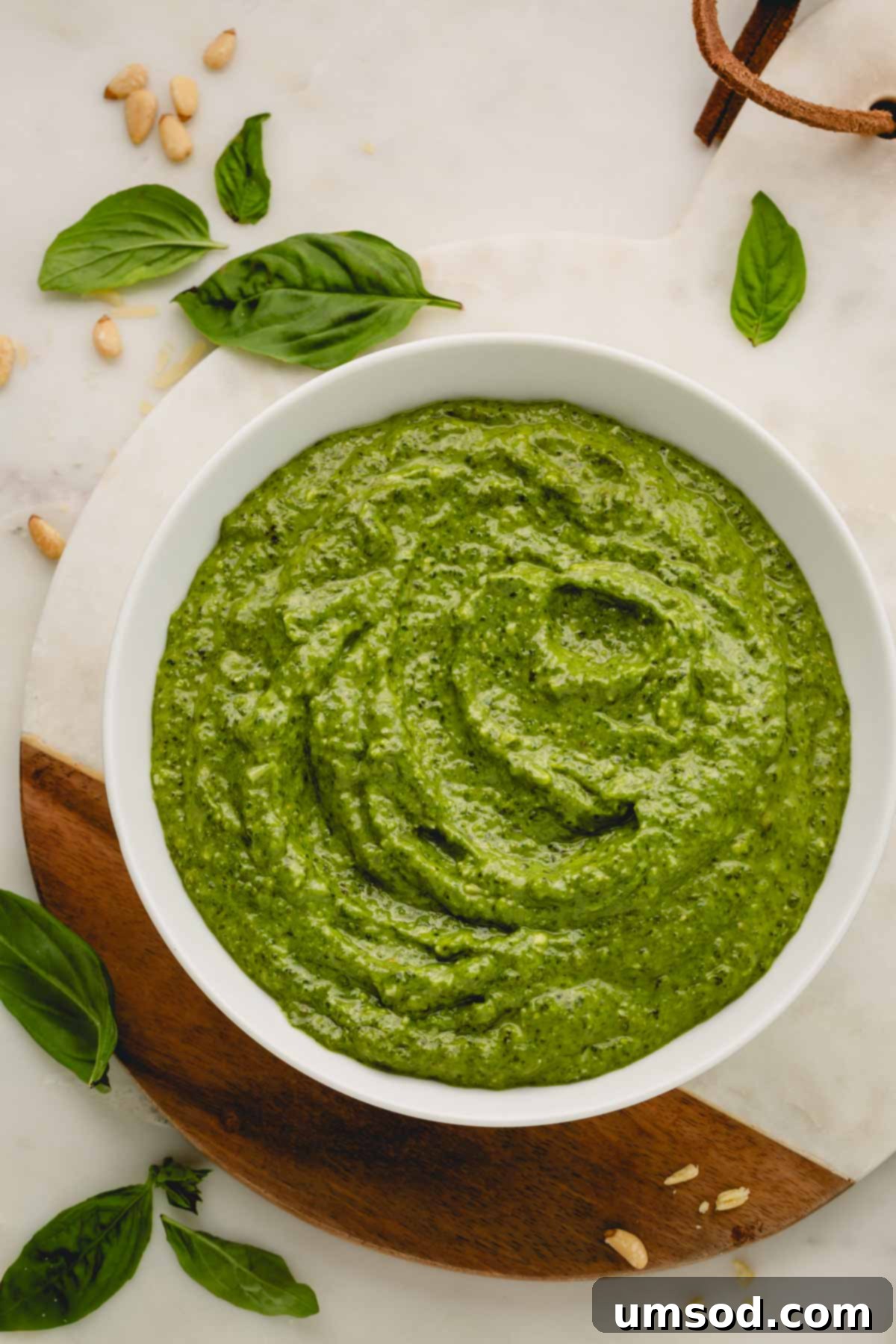
Mastering Your Pesto: Expert Tips for Success
Achieving the perfect basil pesto is simple when you follow these insider tips. Each element contributes to a superior sauce that’s bursting with flavor and boasts an ideal texture:
- Invest in a Large Food Processor: For this generous recipe, a spacious food processor is non-negotiable. I highly recommend using my 14-cup Cuisinart food processor. A smaller model will struggle to accommodate the volume of basil, leading to uneven blending and potential overflow. A larger capacity ensures all ingredients are processed efficiently and uniformly, resulting in that perfectly smooth consistency.
- Toast Those Pine Nuts for Enhanced Flavor: This step is not merely optional; it’s transformative! Toasting pine nuts in a dry skillet brings out their natural oils, deepening their flavor and infusing the pesto with a warm, nutty aroma that simply cannot be achieved with raw nuts. I promise, this subtle yet significant step won’t overpower the sauce but will instead add a layer of complex richness. While walnuts can be substituted, I believe splurging on pine nuts is absolutely worth it for the authentic, delicate taste they impart.
- Customize Your Garlic Intensity: I’m a true garlic devotee, and my recipe calls for a robust amount. However, if you’re not as enthusiastic about garlic’s powerful punch (and who are you?!), feel free to reduce the quantity by half. Keep in mind that as written, this pesto is flavorful but not overwhelmingly garlicky. Another trick to mellow raw garlic’s potency is to briefly toast the peeled cloves in a dry skillet for about 5 minutes over medium heat before adding them to the processor. This softens their bite while retaining their essential flavor.
- Prioritize Quality Parmesan Cheese: The type of cheese you use makes a world of difference. It’s best to buy an actual block of authentic Parmigiano-Reggiano and grate it yourself just before making the pesto. This ensures maximum freshness and flavor. Please, resist the temptation to use the pre-grated “Parmesan” from the green container; its texture and flavor simply don’t compare. You will genuinely taste the difference in the final product. For a slightly different cheesy kick, you could also experiment with Romano or Pecorino cheeses, but Parmigiano-Reggiano is my go-to for its balanced, rich profile.
- Drizzle the Olive Oil Slowly: This is a critical technique for achieving a beautifully creamy, emulsified sauce. As the food processor runs, pour the olive oil into the feed tube in a slow, steady stream. This gradual incorporation allows the oil to properly bind with the other ingredients, creating a stable emulsion that is smooth, luscious, and cohesive. Rushing this step can lead to a separated or oily pesto.

Smart Storage Solutions for Your Big Batch Pesto
This large batch basil pesto recipe is specifically designed for meal prep and future enjoyment, making effective storage crucial. Here’s how to keep your homemade pesto fresh and flavorful:
- Refrigeration (Up to 1 Week): After preparing the pesto as directed, transfer the mixture to an airtight container with a lid. To prevent oxidation and maintain its vibrant green color, pour a thin layer of olive oil over the surface of the pesto before sealing. Store it in the fridge for up to 1 week. This protective oil layer acts as a barrier against air, keeping your pesto looking and tasting fresh.
- Freezing (Up to 6 Months): Freezing is the best way to preserve your big batch pesto for long-term use.
- Using Ice Cube Trays or Silicone Molds: For convenient portioning, divide the pesto into an ice cube tray or a silicone baby food mold. Once completely frozen solid (this usually takes a few hours), pop the pesto blocks out of the mold.
- Storing Frozen Portions: Transfer the frozen pesto cubes to a freezer-safe ziplock bag or an airtight container. Label with the date. Your pesto will remain fresh and flavorful for up to 6 months in the freezer.
- Thawing Instructions: When you’re ready to use your frozen pesto, simply remove the desired number of cubes and thaw them in the fridge overnight or at room temperature for a couple of hours. Once thawed, stir well, and it will taste as vibrant and fresh as the day you made it!
- Freezer Bag Method: Alternatively, you can pour the prepared pesto into a freezer bag, squeeze out all the air, and flatten it. This allows for easy storage and quick thawing, as you can break off small chunks as needed.
With these storage tips, you’ll always have a stash of delicious homemade basil pesto ready to transform any meal!
Frequently Asked Questions About Homemade Basil Pesto
The secret to the best pesto lies in achieving a perfect balance of intense flavor and vibrant freshness. This means using only the highest quality ingredients: tender, bright green basil leaves, a superior extra virgin olive oil for richness, and freshly grated Parmigiano-Reggiano for its complex, nutty notes. Beyond ingredients, the key is to blend just enough to combine and emulsify. Over-processing can generate heat, which can dull the basil’s vibrant color and even lead to a bitter taste. The freezing basil technique also plays a crucial role in achieving an exceptionally creamy texture.
Several common pitfalls can diminish your pesto’s quality. These include using damp basil leaves, which dilutes the flavor and affects texture; overprocessing the ingredients, which can turn the pesto brown and bitter; using stale or untoasted nuts, which lack depth of flavor; and skipping or under-salting, which results in a bland sauce. Also, using pre-grated Parmesan or low-quality olive oil can significantly impact the taste.
Absolutely! Making this basil pesto recipe vegan is straightforward. The easiest substitution is for the Parmigiano-Reggiano cheese. Simply swap it out for an equal amount of nutritional yeast, which provides a wonderfully savory, cheesy flavor profile, or use your favorite store-bought vegan Parmesan alternative. You’ll still achieve a rich, nutty, and incredibly flavorful pesto that is completely plant-based.
Explore More Delicious Homemade Sauces
If you love the satisfaction of making your own sauces from scratch, be sure to check out these other fantastic homemade recipes:
- Garlic Scapes Pesto
- Hot Honey Sauce
- Honey Teriyaki Sauce
- Classic BBQ Sauce

Big Batch Basil Pesto
Comment
Print Recipe
Ingredients
- 10 cups (300 g) packed basil leaves
- 1 cup (140 g) pine nuts
- 1 head of garlic about 15 garlic cloves
- 2 teaspoons kosher salt
- 2 cups (480 ml) olive oil
- 1 cup (320 g) grated Parmigiano-Reggiano
- ¼ cup (60 ml) fresh lemon juice
Instructions
- Wash and thoroughly dry the basil leaves. Arrange the leaves on a baking sheet and freeze for about 2 hours, or until solid. (This step can be prepared in advance; once frozen, transfer the leaves to a gallon-size freezer bag for longer storage.)
- In a medium skillet, toast the pine nuts over medium heat for about 5 minutes, stirring frequently. Be very careful not to burn them. Once lightly golden and fragrant, remove from heat and cool slightly.
- Peel the garlic cloves by smashing them with the flat side of a knife to loosen the skins.
- In a large (14-cup recommended) food processor, combine the frozen basil leaves, cooled toasted pine nuts, peeled garlic, and kosher salt.
- Process the mixture until it becomes smooth and forms a thick paste.
- While the food processor is still running, slowly drizzle in the olive oil through the feed tube until fully incorporated and the pesto is creamy.
- Add the freshly grated Parmigiano-Reggiano and fresh lemon juice. Process for another 30 seconds or just until all ingredients are well combined and the pesto reaches your desired consistency. Avoid over-processing.
⭐️ Did you make this recipe?
Please leave a review and let us know how you liked it!
Tips & Notes
Use approximately ½ cup of prepared pesto sauce per 1lb of cooked pasta for a perfectly coated dish.
Storing Tips:
– Fresh pesto should be refrigerated in an airtight container. To prevent browning, pour a thin layer of olive oil over the surface before sealing. It will stay fresh for up to 1 week.
– This pesto freezes beautifully for up to 6 months.
How to Freeze Pesto:
– Option 1: Pour the prepared pesto into a freezer-safe bag, press out all the air, and flatten it into a thin sheet. This method makes it easy to break off a small chunk or defrost the entire flat portion quickly.
– Option 2: Divide the pesto into an ice cube tray or silicone freezer molds. Once completely frozen, transfer the pesto cubes into a large freezer bag to store. This is ideal for single-serving portions.
Nutrition

Did you make this?Leave a rating and your feedback. Thank you!
This post was originally published on September 15, 2016, and has been updated and expanded to provide even more valuable information and tips for making the best big batch basil pesto.
